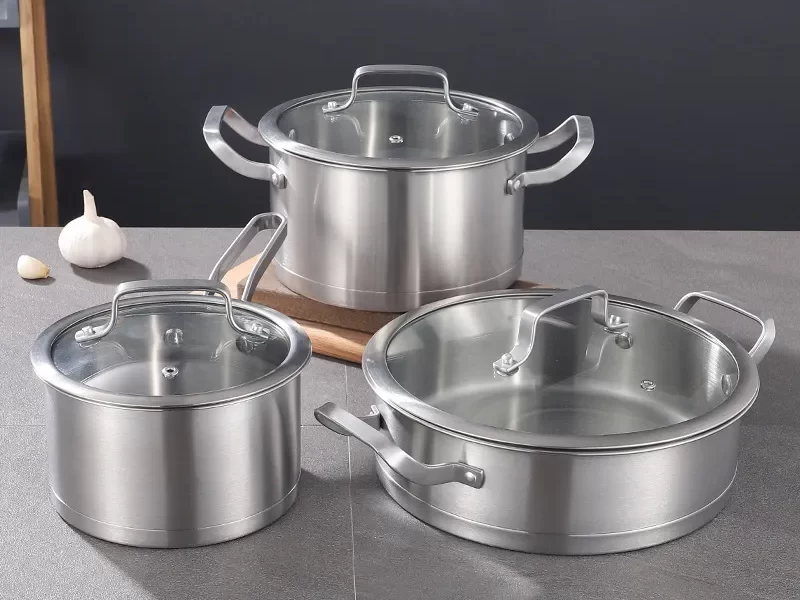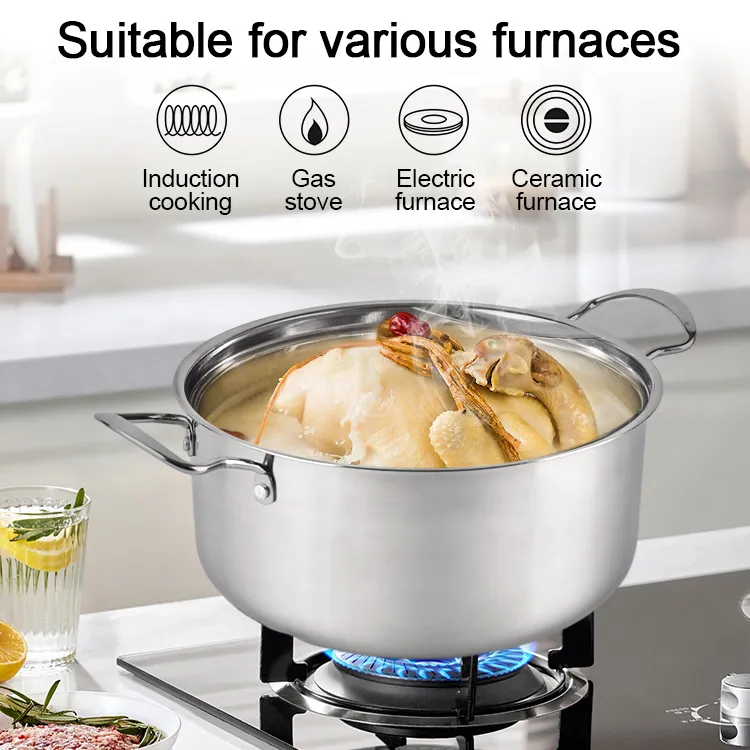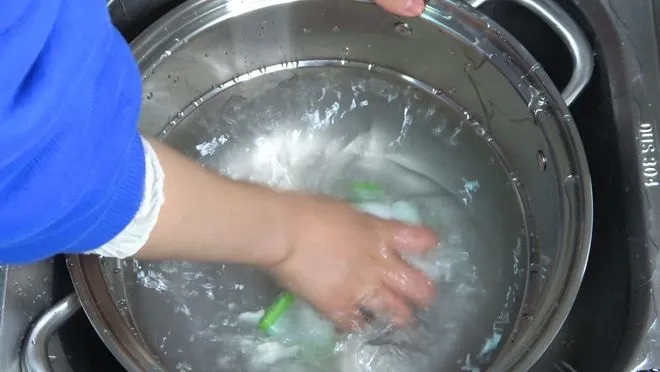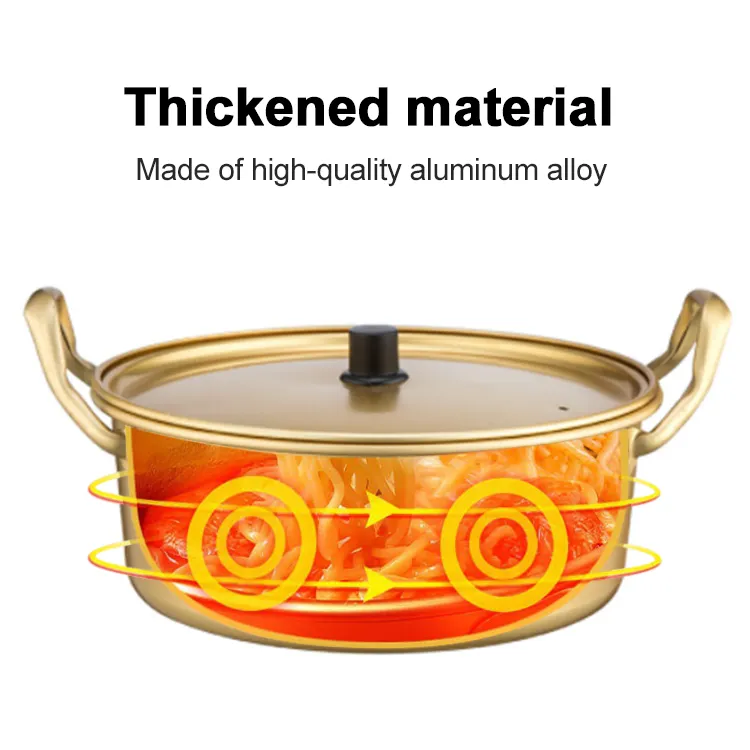
Hier finden Sie einen Leitfaden zur Verwendung Kochgeschirr aus rostfreiem Stahl für ein besseres Kocherlebnis. Ob ein Profikoch oder ein Anfänger, der gerade erst angefangen hat, Kochgeschirr, das die richtige Wahl ist, wird einen Großteil des Kochens verbessern. Edelstahl gilt gemeinhin als langlebig, reaktionsfreudig und pflegeleicht. Allnice hat einen guten Ruf als Hersteller von rostfreiem Kochgeschirr. In diesem Artikel werden die Verwendung und die Pflege von rostfreiem Stahl im Detail erklärt, um zu zeigen, wie er im Laufe der Zeit zu einem zuverlässigen Werkzeug in der Küche wird und das Kochen effektiv macht. Für alle, die nach der Lektüre kaufen möchten, gibt es Edelstahl-Kochgeschirr von Allnice kann eine gute Option sein.
Auswahl von Kochgeschirr aus Edelstahl
Weil rostfreier Stahl Kochgeschirr ist so vielseitig und besonders langlebig, dass es sowohl im Haushalt als auch in der Profiküche die erste Wahl ist. Im Folgenden werden einige der wichtigsten Vorteile der Verwendung von Töpfen und Pfannen aus Edelstahl aufgeführt:
- Strapazierfähigkeit und Langlebigkeit: Rostfreier Stahl ist bekannt für seine Festigkeit und Rostbeständigkeit. Bei richtiger Pflege kann er viele Jahre überdauern.
- Rostfreier Stahl ist nicht reaktiv: Es wirkt nicht wie Aluminium- oder Kupfermetalle, die mit säurehaltigen oder alkalischen Lebensmitteln reagieren, was die Sicherheit der Lebensmittel und ihren Geschmack erhöht.
- Wärmeverteilung und -speicherung: Edelstahl hat nicht die beste Wärmeleitfähigkeit, aber die meisten Töpfe haben einen Boden aus Aluminium oder Kupferverbundstoff. Dadurch wird die Wärme gleichmäßiger verteilt, was örtliche Überhitzung und ungleichmäßiges Kochen verhindert. Dies führt zu einem gleichmäßigeren Kocheffekt.
- Leicht zu reinigen und zu pflegen: Edelstahl hat eine glatte Oberfläche und nimmt in der Regel kein Wasser oder Flecken auf, so dass die Reinigung einfach ist. Außerdem nimmt er in der Regel keine Gerüche auf. Die meisten Kochgeschirre aus rostfreiem Stahl sind auch spülmaschinenfest, was den Zeit- und Arbeitsaufwand für die manuelle Reinigung reduziert.
- Ästhetik: Das saubere, moderne Aussehen von Edelstahl verleiht jeder Küche ein elegantes Aussehen, egal ob sie minimalistisch oder traditionell gestaltet ist, Edelstahl passt gut dazu.

Vorbereitung von Kochgeschirr aus rostfreiem Stahl
Vor dem ersten Gebrauch von Edelstahlkochgeschirr ist eine sachgemäße Handhabung erforderlich, damit die Leistung optimal ist und die Lebensdauer verlängert wird. Im Folgenden finden Sie wichtige Schritte und Dinge, an die Sie denken sollten:
Beseitigung von Produktionsrückständen
Neues Edelstahl-Kochgeschirr kann einige Öle, Schmutz und auch Poliermittel enthalten, die sich auf der Oberfläche der Fabrik befinden können. Deshalb müssen sie vor dem ersten Gebrauch gut gereinigt werden. Die Innen- und Außenseite sollte mit warmem Wasser und milder Seife gereinigt werden. Alle Teile, einschließlich der Griffe und des Bodens der Pfanne, sollten sorgfältig abgewischt werden, damit keine Chemikalien zurückbleiben.
Schritte:
- Geben Sie warmes Wasser in das Kochgeschirr und fügen Sie einige Tropfen milder Spülmittel hinzu.
- Mit einem weichen Schwamm oder Tuch wird die Oberfläche des Kochgeschirrs vollständig abgeschrubbt.
- Trocknen Sie es mit einem weichen Tuch ab, nachdem Sie es gründlich mit Wasser abgespült haben.
- Inspektion auf Schäden wie Kratzer
Würzen des Kochgeschirrs
Auch wenn Edelstahl nicht so "gewürzt" wird, wie es bei Gusseisen erforderlich ist, kann eine leichte Vorbehandlung verhindern, dass die Speisen beim Kochen am Boden der Pfanne haften bleiben. Die Oberfläche wird mit einer dünnen Ölschicht überzogen, die die Antihafteigenschaften verbessert. Dies ist bei Woks und Pfannen nützlich, um das Anhaften von Speisen während des Kochens zu verhindern.
Schritte:
- Stellen Sie es auf den Herd und warten Sie einige Minuten bei mittlerer Flamme.
- Sobald die Pfanne erhitzt ist, sollte etwas Öl - zum Beispiel von Oliven oder Canola - hinzugegeben werden.
- Das Öl muss so bewegt werden, dass es den größten Teil der Pfannenoberfläche gleichmäßig bedecken kann.
- Wischen Sie das überschüssige Öl ab, nachdem Sie die Pfanne abgekühlt haben, und schalten Sie den Herd vorher aus.
Sanfte Wärmeanwendung

Wenn Sie zum ersten Mal Pfannen aus rostfreiem Stahl verwenden, ist es wichtig, dass Sie die Hitze richtig handhaben. Der Stahl gibt die Hitze schnell weiter, und bei Überhitzung können die Speisen festkleben, oder die Pfanne selbst kann sich durch die Hitze verfärben. Es empfiehlt sich, mit mittlerer bis niedriger Hitze zu beginnen, da die Hitze dann gleichmäßiger in der Pfanne verteilt wird.
Schritte:
- Das Kochgeschirr muss etwa 1 bis 2 Minuten vorgeheizt werden, bevor die Zutaten hineingegeben werden.
- Lassen Sie die Pfanne jedoch nicht über einen längeren Zeitraum ohne Zutaten auf dem Herd stehen, da die Edelstahloberfläche sonst zu heiß werden könnte, was zu dauerhaften Flecken führen könnte.
Vermeiden Sie die Verwendung harter Utensilien
Die Oberfläche des Kochgeschirrs aus rostfreiem Stahl ist zwar widerstandsfähig, muss aber dennoch gepflegt werden, da bei der Verwendung von Metallwerkzeugen Kratzer entstehen. Für den erstmaligen Gebrauch wäre es ratsam, Werkzeuge aus Silikonholz oder Nylon zu verwenden, um den Glanz und die Schönheit der Töpfe zu erhalten. Metall kann Kratzer verursachen, die das Aussehen beeinträchtigen können.
Wenn Sie diese Maßnahmen befolgen, bleibt das Kochgeschirr aus Edelstahl von Anfang an in gutem Zustand und Sie können die meisten der üblichen Probleme vermeiden. Häufige Probleme wie das Anhaften von Lebensmitteln, Verfärbungen und Kratzer sind bei entsprechender Sorgfalt weniger wahrscheinlich.
Wie man mit Edelstahl-Kochgeschirr kocht
Kochgeschirr aus Edelstahl ist eines der vielseitigsten Töpfe und Pfannen, mit denen man kochen kann, aber es gibt ein paar wichtige Dinge, die man wissen muss, um eine optimale Leistung aus ihnen herauszuholen. Im Folgenden finden Sie einige sehr praktische Kochtipps für Edelstahlgeschirr, die Ihnen helfen, Ihr Edelstahlgeschirr richtig zu verwenden, das Anhaften von Speisen zu verhindern, ein gleichmäßiges Garen zu gewährleisten und den gesamten Kochvorgang zu erleichtern.
Vorheizen des Kochgeschirrs
Lassen Sie die Pfanne oder das Kochgeschirr vor dem Garen auf mittlerer Stufe 1-2 Minuten vorheizen, um heiße Stellen zu vermeiden, an denen das Essen am Boden kleben bleiben könnte.
Fügen Sie die empfohlene Menge Öl oder Kochspray hinzu, nachdem das Gerät vorgeheizt wurde.
Richtige Kochtemperatur verwenden
Edelstahlkochgeschirr hat gute Wärmeübertragungseigenschaften, aber eine zu hohe Temperatur kann Lebensmittel verbrennen oder sogar Töpfe und Pfannen verformen. Bitte passen Sie die Hitze daher den unterschiedlichen Kochbedürfnissen entsprechend an.
Zum Beispiel: Sautieren bei mittlerer bis hoher Hitze, Schmoren bei mittlerer bis niedriger Hitze.
Um das Anhaften von Lebensmitteln auf dem Kochgeschirr
- Es sollte eine angemessene Menge Öl verwendet werden: Heizen Sie die Pfanne vor und geben Sie eine ausreichende Menge Öl oder Kochspray hinein, so dass das Öl einen dünnen Film auf dem Boden der Pfanne bildet und die Speisen nicht an der Pfanne kleben bleiben. Alternativ können auch einige Tropfen geschmolzene Butter oder Pflanzenöl hinzugegeben werden, um die gleiche Wirkung zu erzielen.
- Vermeiden Sie es, die Speisen zu oft zu wenden: Das Essen sollte nicht sofort umgedreht werden, wenn es in die Pfanne kommt. Lassen Sie die Speisen nur wenige Sekunden auf dem Boden der Pfanne liegen, damit sie sich auf natürliche Weise lösen. So entwickelt sich die schöne goldbraune Karamellschicht und das Essen bleibt nicht kleben. Stoßen Sie mit einem Pfannenwender an; wenn sich das Essen leicht bewegt, ist es bereit zum Wenden.
- Verwenden Sie die richtigen Zutaten: Einige Zutaten wie Eier oder Fisch neigen dazu, am Boden der Pfanne zu kleben. Wenn solche Zutaten verwendet werden, kann man entweder eine antihaftbeschichtete Pfanne verwenden oder die Edelstahlpfanne vor dem Erhitzen mit etwas Öl einreiben.

Geeignete Utensilien verwenden
Um die Oberfläche von Töpfen und Pfannen aus rostfreiem Stahl nicht zu zerkratzen, ist es ratsam, darin nur Küchenwerkzeuge aus Holz, Silikon oder Nylon zu verwenden. So vermeiden Sie, dass Sie mit Metallwerkzeugen den Boden von Töpfen und Pfannen abkratzen, wenn Lebensmittel am Boden festkleben; das schont die Oberfläche und verlängert die Lebensdauer von Töpfen und Pfannen.
Reinigung und Pflege von Kochgeschirr aus Edelstahl
Gute Reinigungs- und Pflegepraktiken erhalten nicht nur die Oberfläche Ihres Edelstahlgeschirrs in gutem Zustand, sondern schützen es auch. Im Folgenden finden Sie einige der wichtigsten Tipps zur Reinigung und Pflege Ihres Edelstahlgeschirrs:
Mit warmem Wasser und Spülmittel waschen


Waschen Sie Ihre Töpfe und Pfannen sofort nach dem täglichen Kochen ab, damit die Essensreste nicht lange auf dem Topfboden festbrennen und die Reinigung erschweren. Insgesamt benötigen Töpfe und Pfannen aus Edelstahl zur Reinigung nur warmes Wasser und ein mildes Reinigungsmittel.
Schritte:
- Weichen Sie das Kochgeschirr für einige Minuten in warmem Wasser ein.
- Mit einem Schwamm oder einem weichen Tuch, das mit einigen Tropfen Geschirrspülmittel befeuchtet ist, innen und außen leicht reinigen.
- Spülen Sie das Kochgeschirr unter fließendem Wasser ab.
- Trocknen Sie das Gerät mit einem weichen Tuch oder Handtuch ab, vor allem an der Unterseite und den Seiten, um Wasserflecken auf der Oberfläche des Edelstahls zu vermeiden.
Umgang mit problematischen Lebensmittelrückständen
Trotz aller Vorsichtsmaßnahmen lässt es sich nicht vermeiden, dass manchmal hartnäckige Essensreste am Boden der Pfanne haften bleiben. Kratzen Sie den Boden mit dem harten Reinigungswerkzeug direkt ab, so dass Kratzer auf der Edelstahloberfläche entstehen können. Entfernen Sie stattdessen hartnäckige Flecken durch Einweichen oder mit einem Reinigungsmittel.
Schritte:
- Weichen Sie das Kochgeschirr 10-15 Minuten lang in warmem Wasser ein, um hartnäckige Speisereste für die Reinigung zu lösen,
- Wenn die hartnäckigen Flecken immer noch nicht gut gereinigt sind, stellen Sie das Kochgeschirr wieder auf den Herd, füllen Sie es mit Wasser, fügen Sie eine kleine Menge Backpulver hinzu und lassen Sie es einige Minuten lang auf niedriger Stufe erhitzen, damit es gut reinigt.
Optimale Ergebnisse bei langfristiger Pflege
Regelmäßiges Polieren und Wartung
Selbst bei ordnungsgemäßer Reinigung kann Kochgeschirr aus Edelstahl mit der Zeit seinen ursprünglichen Glanz verlieren. Regelmäßiges Polieren stellt den Glanz wieder her und schützt die Edelstahloberfläche vor Oxidation und Korrosion.
Tipps zur Lagerung:
- Bewahren Sie Töpfe und Pfannen an einem trockenen und gut belüfteten Ort auf, um Rostbildung durch eine feuchte Umgebung zu vermeiden.
- Sie können Topflappen oder Topfdeckel verwenden, um zu vermeiden, dass Töpfe und Pfannen gegeneinander stoßen und Kratzer verursachen.
Vermeiden von Verfärbungen und Schäden in Kochgeschirr aus Edelstahl
Obwohl Kochgeschirr aus rostfreiem Stahl sehr robust, korrosionsbeständig und beliebt ist, kann es bei unsachgemäßer Verwendung Verfärbungen, Kratzer und andere Schäden davontragen. Richtige Schutzmaßnahmen und Reinigungsmethoden beugen Verfärbungen vor und sorgen dafür, dass Ihr Edelstahlkochgeschirr lange Zeit so gut wie neu aussieht. Im Folgenden finden Sie einige praktische Tipps zur Vermeidung von Verfärbungen und Schäden an Kochgeschirr aus rostfreiem Stahl:
Meiden Sie extrem hohe Hitze
Nichtrostender Stahl ist sehr hitzebeständig; sehr hohe Temperaturen können jedoch die Oberfläche verbrennen und hinterlassen in der Regel blaue oder schillernde Flecken. Dies ist im Allgemeinen auf die Oxidation des Chroms in nichtrostendem Stahl bei sehr hohen Temperaturen zurückzuführen.
Vorbeugende Maßnahmen:
- Wir empfehlen immer eine niedrige bis mittlere Hitze, es sei denn, das Rezept verlangt nach mehr.
- Wenn hohe Hitze erforderlich ist, muss die Innenseite des Kochgeschirrs mit Öl oder Flüssigkeit gefüllt sein, damit die Temperatur nicht sofort in die Höhe schießt.

Hitzeflecken und Wasserflecken regelmäßig entfernen
Hitze- und Wasserflecken - Diese Vorkommnisse sind bei der Verwendung von Kochgeschirr aus Edelstahl sehr häufig. Sie entstehen in der Regel durch ungleichmäßige Erhitzung oder durch Mineralablagerungen im Wasser. Diese Flecken beeinträchtigen nicht nur das Gesamtbild des Kochgeschirrs, sondern können auch die Oberfläche beschädigen.
Wie man sie entfernt:
- Sie können die verfärbten Stellen oder Wasserflecken mit weißem Essig einreiben und mit einem weichen Tuch trocknen.
Vermeiden Sie die Lagerung von säurehaltigen Lebensmitteln in großen Mengen
Zu den säurehaltigen Lebensmitteln gehören Tomaten, Essig oder Zitrusfrüchte, die eine leichte chemische Reaktion mit rostfreiem Stahl eingehen. Längerer Kontakt kann zu Korrosion oder Verfärbung der Oberfläche führen. Daher dürfen säurehaltige Lebensmittel nicht sehr lange in Kochgeschirr aus Edelstahl aufbewahrt werden.
Vorsichtsmaßnahmen:
- Vermeiden Sie es, säurehaltige Zutaten längere Zeit im Edelstahlkochgeschirr liegen zu lassen, und reinigen Sie das Kochgeschirr nach dem Kochen sofort.
Kochgeschirr aus rostfreiem Stahl ist einen Versuch wert.

Wir ermutigen jeden Leser, Edelstahl auszuprobieren Kochgeschirr und erleben Sie seine Bequemlichkeit und Effizienz. Bei richtiger Verwendung und Pflege können Sie nicht nur Ihr Kocherlebnis verbessern, sondern auch Ihr Kochgeschirr für eine lange Zeit in einem Top-Zustand erhalten. Geld für Edelstahl-Kochgeschirr auszugeben ist ein entscheidender Schritt in Richtung eines gesunden und geschmackvollen Lebensstils, daher ermutigen wir Sie, sich für Allnice Kochgeschirr! Willkommen bei uns!








